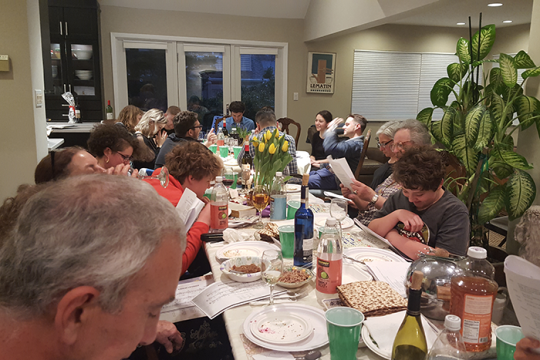I was sitting in front of the TV last week, laptop in position, watching the PGA Waste Management Open from Phoenix. It's a golf tournament, so there's a lot of downtime, during which I checked Facebook, scrolled through my Twitter feed (if you follow me, I'll follow back), and read Men's Journal, Outside Magazine, and the New York Times. (Like I said: There's a lot of down time.) I found an article from the Times on the winter Shabbat dress patterns of the Chasidim, titled "Dressing for the bitter cold but still observing the Sabbath," to be intriguing.
I understand that working on the Sabbath is forbidden. Rather, what caught my attention about the story was the lengths to which the Chasidim follow this directive. No gloves, I learned; that is considered "carrying," and carrying is considered work. No pockets either, for the same reason.
Let me be clear: There's no ridicule here, just curiosity. I grew up in the Midwest suburbs, hearing about Chasidim as if they were the "Jewish Amish," a subset of strict constructionists with whom I had no interaction. Indeed, as Spock would say, "Fascinating."
I am aware that, as Jews, we are commanded to observe 613 mitzvot. Am I familiar with - or observant of - all 613? No. But I have managed to raise a good kid, have a good marriage, generally stay out of trouble and lead a good life without consciously following the 613. How did I manage this? At its heart, all Judaic law can be boiled down to one commandment: "What is hateful to you, do not do to others."
This much, I can do. Six hundred and thirteen mitzvot? Not so much.
Back to golf. Golf is a simple game. The object is to hit the ball from the teeing area into the hole, using as few strokes as possible. Golf only gets complicated when one tries to follow the "Rules of Golf." There are a mere 34 rules. However, there are more than 100 subsections to these rules. In addition, there are more than 2,000 explanatory decisions needed to explain the original 34.
Let's take a look at the United States Golf Association's "Rule of the Day" from February 12, 2013. This rule examines casual water (water that is just lying there on a hammock, I suppose, with a gin and tonic in hand?) versus a "true water hazard":
25-1b/13 Casual Water Mistaken for Water Hazard; Substituted Ball Played Under Water Hazard Rule
Q: A player whose ball is in casual water mistakes the casual water for a water hazard. The player does not retrieve his original ball, although he could have done so without unreasonable effort -- see Decision 25-1/1. Rather, he drops another ball ten yards behind the casual water in accordance with the water hazard Rule and plays it. His error is then discovered. What is the ruling?A: Since the player could retrieve the ball without unreasonable effort, he was not permitted to substitute a ball in taking relief from the casual water. Additionally, as a result of proceeding under the water hazard Rule (Rule 26-1), he dropped the ball in a wrong place. In match play, the player loses the hole (Rules 15-2, 25-1b(i) and 20-7b). In stroke play, the player incurs a penalty of two strokes. Although the player substituted a ball when not permitted (Rule 15-2 and Rule 25-1) and played from a wrong place (Rules 25-1b(i) and 20-7c), the Exception to Rule 15-2 and Note 3 to Rule 20-7 explain that a player who substitutes a ball and plays from a wrong place incurs a total penalty of two strokes. (Revised)
Got it? If you actually read and understood that ruling, you most likely work in the IRS code department. Yet golf's rules boil down to two commandments: If you swing, it's a stroke; if you get in trouble, it costs you strokes to get out.
Compare the Rule of the Day to a similarly arcane Jewish rule: the wearing of mixed wool & linen garments. Leviticus 19:19 states that it is forbidden to wear shatnez, a mixture of wool and linen. In the words of the Torah, "You shall observe My statutes. A garment which has a mixture of shatnez shall not come upon you." Why? According to Chabad.org, "This means that this mitzvah is a chok-a divine statute that defies comprehension." In other words, "just because." Some scholars have said the prohibition against shatnez results from Cain's offering of flax and Abel's of sheep; the mixing of wool and linen might again unleash those evil forces. However, most modern commentators say it is a "because we say so" issue, and Chabad lists seven explanatory decisions on this issue.
Six hundred and thirteen commandments, each with a multiplicity of sub-commandments and rulings. Thirty-four rules with 100 subsections and 2,000 explanations.
Golf: If you swing, it's a stroke. Judaism: Don't be a jerk to other people. Golf and Judaism are, it seems, a perfect match.
David Stanley is a member of Temple Beth El in Flint, MI. He is a teacher, athlete, coach, and cancer survivor blogging about education, cancer, sport, society at DStan58-Rants & Mutters .
Related Posts

Harnessing the Power of our Mothers Around the Seder Table

Melding Tradition and Innovation: Our Interfaith Toddler Naming Ceremony

